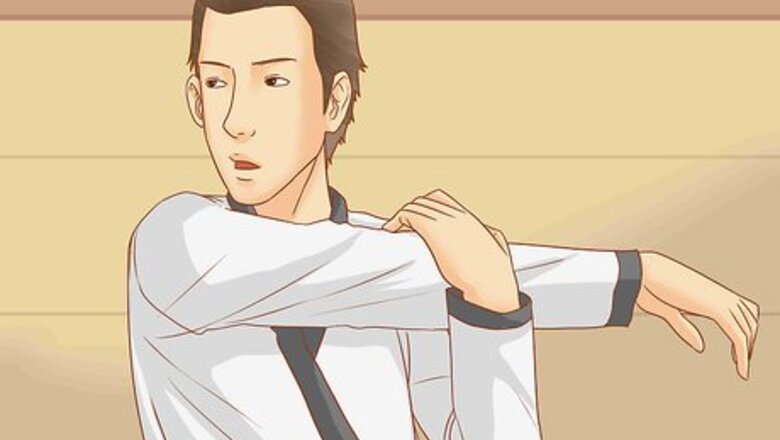
views
Before starting the practice
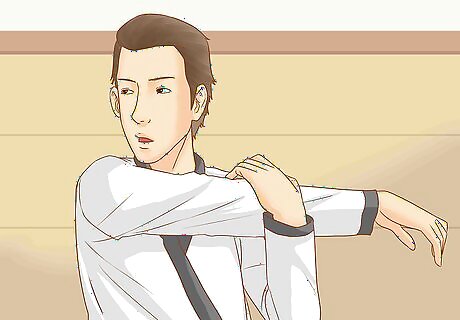
Make sure your whole body is limber before practicing poomsae. You will need to spend at least 30 minutes to an hour to do basic, daily stretching before each practice.
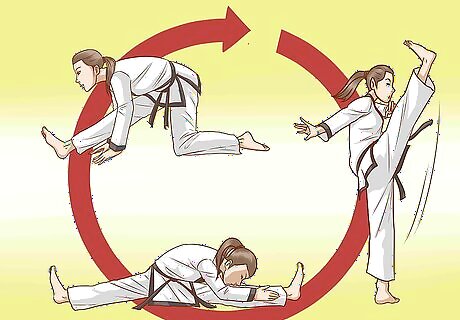
Here is a basic routine you can try: Start with 30 jumping jacks, then bend all the way forward and back for counts of 10. Do 10 total reps. Then stretch the side of your body by putting your arm on one hip and using the other arm to reach for the other side, and then switch. Stretch your knees by alternating between bending them and straightening them. After that, circle them to the right 10 times and then to the left 10 times. This is really important because unfortunately knee injuries are incredibly common in TKD. Do the half splits by bending one knee and extending the other leg and put your head to your knee. Repeat with another leg. Do a 10 count of 10 total reps. Center split. Sit in the center split and go as far as you can for 10 minutes then sit down and take turns stretching by putting your head to your knee on the left, right, and center. Do a 10 count of 5 reps each. Front splits (both ways), stay in them for 10 min at a time. If you want to take it a step further sit as far as you can go and put your forehead to your shin for each side. End with butterfly stretch. Try to push your knees all the way to the ground, and end with putting your nose to the toes or to the ground. Stretch with kicks: point your toes and keeping your leg straight, swing it as high as possible. Do 10 kicks with each leg. Jog a few laps.
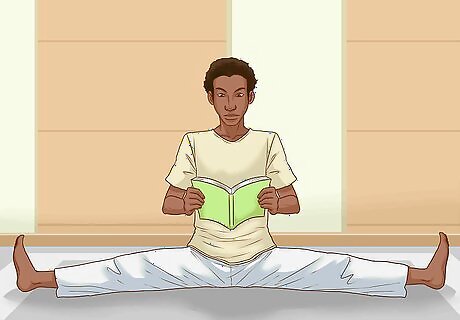
It is very important to stretch the legs in Poomsae. Definitely consider stretching in your free time to try to improve on your flexibility: Sit in full splits for half an hour to an hour a day while reading, doing homework, or watching TV. Then do front-splits for each leg for about 20 minutes at a time. Try to go deeper every time - you can try standing on X-ray paper and letting your legs slide (but be prepared to have your hands ready to help you stop), or prop your feet up on both sides to deepen the center split. You can also do the butterfly stretch and have someone press down on your knees from behind (or stand on them). The more time you can dedicate to stretching, the closer you can get to a vertical sidekick!
Stances
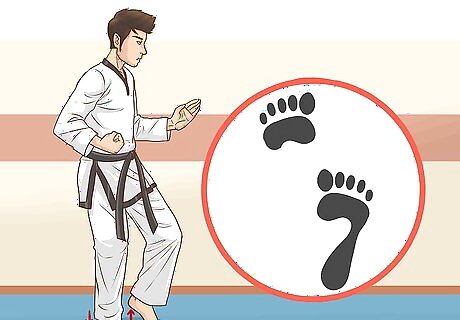
Cat stance or beom sohgi. Place your feet shoulder width apart. Take a half step to your side and turn your front foot to be in line with the body. Slightly bend your front knee. Bend your back leg to make a 90 degree angle. Back foot should be perpendicular to the front foot and the heels of your feet should be on the same line. Keep the heel of the front foot off the ground. Keep your back straight and your hips squared.
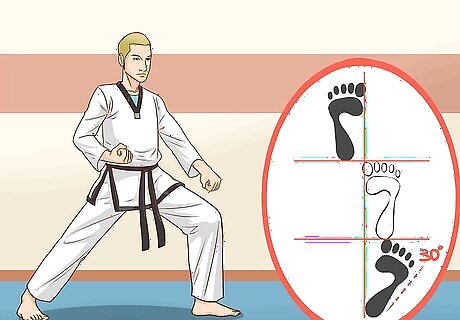
Front stance or ahp sohgi. Stand with your feet shoulder length apart. Take a big step forward with the front leg and bend your knee, almost as if you are doing a lunge. Your feet should be facing forward. Bend your front knee to be at 90 degree angle. Your back leg should be straight. Keep your hips straight and pointed to the front.
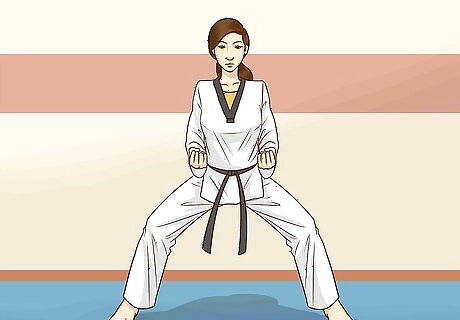
Horse stance or juchoom sohgi. Move your feet to the sides about two shoulder lengths apart. Bend your knees, as if you are sitting on a chair or riding a horse. Your feet and hips should face forward. Keep your back straight.
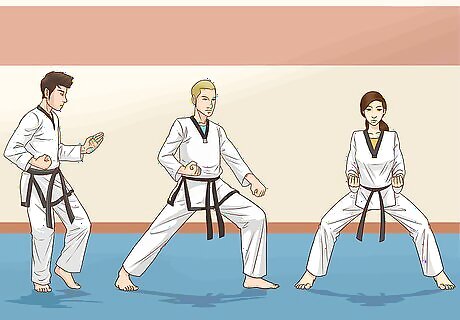
Practice doing the form with just the stances first. Put your hands on your hips and keep them there the whole time. Practice going through the stances of the form in full first, until your movements are perfect. Either have someone watch you and correct you after each movement, or practice in front of a mirror (stopping to check after each stance). Make sure that your back is straight and your shoulders are square in each movement. Your shoulders should also be lined up.
Kicks
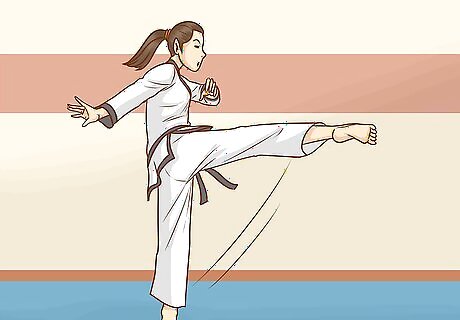
Practice kicks separately first. The kicks in Taekwondo have evolved over time. Kicks in Poomsae are traditional kicks, while kicks for fighting are more about power and speed. Balance is important, use full range of motion, and show power. Practice balance first. While this comes with practicing kicks overtime, you can do additional exercises to practice if this area needs the most improvement. Practice standing on one leg for an extended period of time and finding your center of balance. Switch legs! Once you have this down, try hopping on one leg across a room. Switch legs! You may find that it is easier for you to do this on one leg versus another - but the other leg has just as much potential. Be sure to always practice both legs - who knows, your weaker leg may end up being your stronger leg! Then work on kicks. The traditional kicks exhibited in Poomsae require a full range of motion. While the kicks and actual movements may be different, the process is the same. First, bring your knee all the way into your chest. When you kick, make sure that your leg is extended all the way in a straight line (if this is a sidekick, make sure your back is a continuation of this line, in most instances you need to arch your back further back to get that line). Similar to the hand movements, you should stick the kick at the end of the extension. After sticking your kick, bring your leg all the way back into your chest. Then bring your leg down the the floor in a controlled manner.
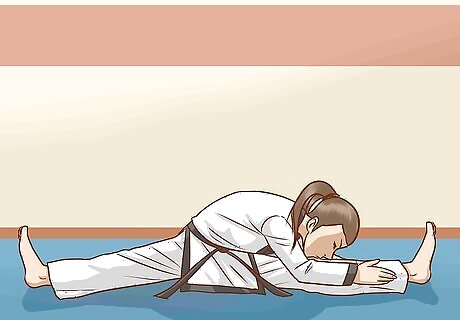
Work on your flexibility. Flexibility helps a lot in patterns (hence all the suggested stretching!). This is when you will have to be able to do the splits, all three ways. Meaning you must stretch everyday! If you're naturally flexible, you're making people jealous. But that doesn’t mean you still don’t need practice.
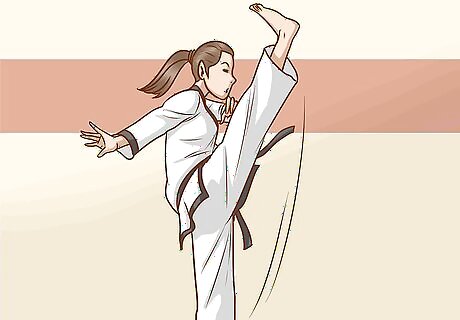
Work on the height of your kicks. When you are doing patterns, the height of your kick counts. If you kick around your nose and you forehead, that's pretty good. But if you want to blow your master away, kick above you head. The higher the better. This is a combination of flexibility and balance. To work on this type of balance, you can practice your kicks by holding onto something first. You can also practice by kicking up/along a wall while holding onto someone or something. It will take a lot of practice to build strength to get these kicks exactly right, and a lot of practice in general! Karate means open hand way. It is more hand based than kicks, whereas, Taekwondo is heavier on the kicking area than in the hand techniques. In some styles, there are about 70% kicks and 30% hand techniques. For example, The Tae-Gup style tends to be very heavily kick based, where 70% to 75% of the techniques are kicking. Other styles are a little more balanced. The Chang-Hon style is almost 50-50 hands and feet.
Put all the movements together
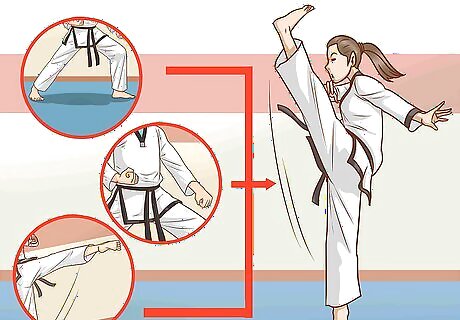
Once you get all the basic movements down, put them all together! First go through each movement: stance, hand movement, and any kicks. Stop after each movement to make sure that everything is still accurate. Feel free to start slow until you get the combination of all the movements correctly while maintaining proper form. Then show power in your hand movements, in your stance, and in your face - focus! Even with the power added, the movements should remain consistent: you should not lose balance, stance, or any detail.
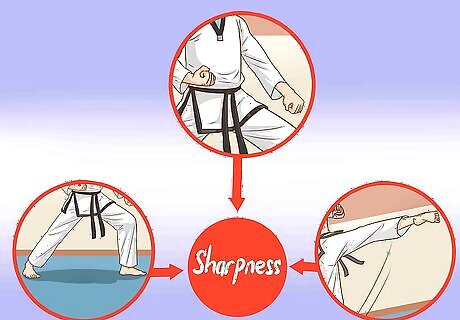
Add sharpness to all movements when they are perfect. Make sure you are sticking your hand movements, your stances, and your kicks.
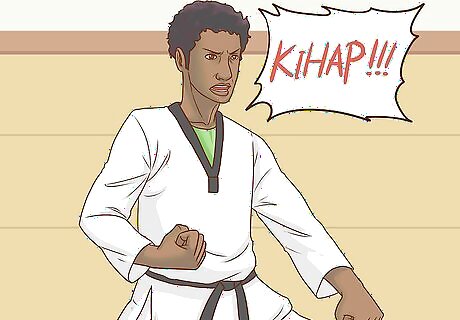
After that, add intensity. Intensity is harder to describe, but it’s the effort you show in each movement, and in your face, as you go through your form. You can also show this with yelling “kihap" extra loud at the appropriate parts of the form.
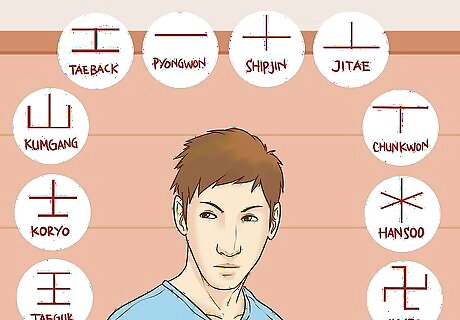
Memorize patterns. Be diligent while committing to practicing forms. Your goal should to be to continually improve, step by step. Set aside time every day to stretch, do drills to improve areas you need work on, practice, and review your progress. Make sure you get every movement exactly right, but don’t be discouraged if you do not, just try it again! Patterns can be harder than sparring. This is because you only have one shot in winning a poomsae competition. One shot to make everything exactly right. In sparring, if they kick you, or if you kick them, a point is gained. Memorizing patterns is important. If you forget a pattern halfway, you cannot win. To take it a step further and commit your physical memory to getting every movement right is even more difficult! But if you believe in yourself it can be done!
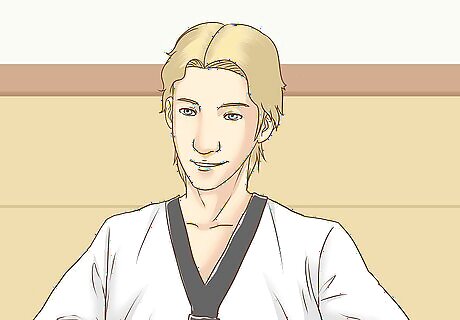
Have fun! Practice makes perfect. It is like building a house from the ground up - you need a strong foundation. Seeing your final result after all your hard work and being able to share it is the most satisfying result!




















Comments
0 comment